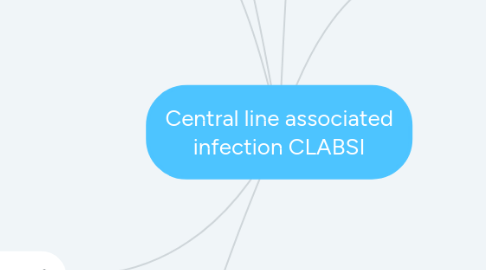Central line associated infection CLABSI
by Andrew Cunningham


1. CDC. (2010, April 1). Central Line-Associated Bloodstream Infections. Retrieved from Resources for Patients and Healthcare Providers: https://www.cdc.gov/hai/bsi/clabsi-resources.html CDC. (2011, March). CDC VitalSigns . Retrieved August 22, 2017, from Making Health Care Safer; Reducing bloodstream infections: https://www.cdc.gov/vitalsigns/pdf/2011-03-vitalsigns.pdf Liang, S. Y., & Marschall, J. (2011, November). Vital Signs: Central Line-Associated Blood Stream Infections-United States, 2001, 2008, and 2009. Annals of Emergency Medicine, 58(5), 447-450.
2. Statistics
2.1. Roughly 41,000 CLABSI's occur each year
2.2. 90% of CLABSIs that happen yearly are from kidney dialysis patients
3. Disease Organisms
3.1. Coagulate-negative Staphylococcus
3.2. Methicillin-resistant Staphylococcus aureus MRSA
3.3. Enterococcus species (VRE & VSE)
3.4. Candida species
3.5. Escherichia coli
3.6. Enterobacter species
3.7. Klebsiella species
3.8. Pseudomonas species
3.9. Acinetobacter species
4. Definition
4.1. A CLABSI is a serious infection that occurs when germs enter the bloodstream through a central line.
5. Prevention
5.1. Follow strict protocol to make sure line remains sterile.
5.2. Hand hygiene
5.3. Apply appropriate skin antiseptic
5.4. Ensure the skin prep agent has completely dried before inserting the central line
5.5. Use sterile barrier precautions
5.6. Follow central line maintenance practices
5.7. Hand hygiene before and after handling the central line
5.8. Removal of central line as soon as it is no longer needed
6. Research
6.1. Research conducted in this area revolves around the prevention techniques and associated infection rate reductions. These include the following
6.1.1. Education programs for medical personnel involved.
6.1.2. Proper hand hygiene using chlorhexidine skin antiseptics
6.1.3. Maximal barrier precautions upon insertion
6.1.4. Preferential use of the subclavian vein
